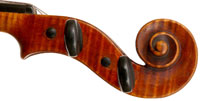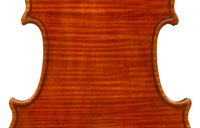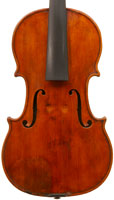Ref : 0741
A fine French violin by
Joseph Nicolas fils
(1796 - 1864)
Mirecourt, 1830
With certificate by J.J. van de Geest (1952)
The Dutch violin maker and authority, J. J. van de Geest (1899 - 1974), identified this violin as the work of Joseph Nicolas Fils (1796 - 1864) from Mirecourt, made in 1830. Van de Geest was certainly qualified to make such an assertion, having been studio manager for George Hart & Son in London for 18 years until 1938, a period during which he established his reputation internationally as maker, restorer and authority on old instruments. The violin currently bears a 1950 handwritten label by Van de Geest giving the above attribution. A later accompanying certificate, dated 1952, affirms Van de Geest's attribution to Joseph Nicolas Fils.A closer look at the identifiers in this violin underlines the fact that Joseph Nicolas' work is almost identical to that of his more illustrious and respected father, Didier Nicolas (1757 - 1833). The son succeeded his father around 1816. Whereas Vannes indicates that the son always branded his instruments, this violin bears no brand anywhere. However, what removes all doubt that this violin is the work of Joseph Nicolas Fils, is that it bears his known signature in ink in the back, next to the soundpost (see photo).
Furthermore, descriptions of the work of Joseph Nicolas correspond well to this violin, in particular to the f-holes, described as being quite open in the centre with the wings cut off almost horizontally. The model is also broader with higher arching - certainly the case in this violin, which appears somewhat broader than usual; with a back length of 364 mm, it surpasses the norm by a good 7 mm (!). And yes, it is broader too. Vannes also describes the varnish as being brownish yellow to red-brown with a tinge of yellow - a very correct description of this violin's varnish, which is brownish yellow and appears still to be original.
The instrument is in truly superb condition with no serious repairs in evidence anywhere. One can discern two minor cracks, professionally repaired, probably by Van de Geest, and hardly visible.
What strikes one in this violin is the beautiful one-piece back of nicely flamed maple with a distinct narrow curl running straight across the back. The edges are strong and the corners rounded and soft, rather than angular. The purfling is very well-traced. The scroll is really splendid, beautifully refined, strong and superbly balanced - the work of a master craftsman. There is no neck-graft and all the pegholes are bushed.
This violin is well-toned.
 |
 |
 |
||
 |
Dimensions : Back length: 36.4 cm; upper bouts: 17.2 cm; c-bouts: 12 cm; lower bouts: 21.3 cm.
Condition : Superb condition. Two minor cracks have been professionally repaired and cleated, probably by J J van de Geest, and are almost indiscernable. No wing cracks. All pegholes are bushed. All parts and varnish appear original. A thin wedge has been inserted under the fingerboard.
Provenance : Withheld
Price : P.O.A.
 |
 |
 |
 |
 |
 |
 |
 |
 |
 |
 |
 |
|||||
 |
 |
 |
 |